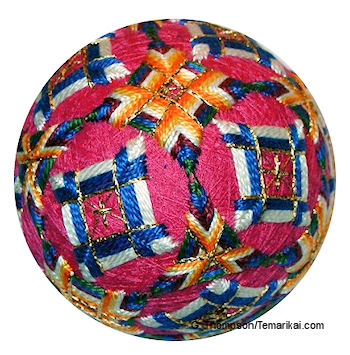TemariKai ToolKit - Sakasa Kagari 逆 さ

Sakasa Uwagake Kagari uses uwagake kagari on corners or points of a shape, working from the outside edge into the center. This is opposite or "inside out" from the usual path of working from the center of a design outward. It may be worked on one or all points/corners of a stitching path. It will very often be used to create polygons, or other solid or partially filled areas. The design shown in the stitching example is an 8-point woven star since it will also demonstrate a few extra points to keep in mind over simple shapes. However, sakasa uwagake applications are almost limitless. It can be used with any shape as well as linear orientations. It can be worked solidly, as open shapes, or even as open rows.
| For this example of using Sakasa Uwagake, an 8-point woven
star is being worked. Stitches are worked on every third line
follow in order from 1 to 8, back to 1, using the 8 marking
lines of the center of an 8-Combination division. Notice the threads cross each other both on the marking lines as well as in between (yellow pin, and immediately the the right and left of the pin), all around the design. When stitching saksa, pay attention to whatever crossovers occur. Be sure to maintain alignment and position of the threads, and groom them as you work. |
| Sakasa Uwagake works in toward the center of the shape, rather than outward from the center as in most other work. Pay attention to the thread cross overs as the design weaves onto itself. The shape can be fully filled or left with some partial negative space in the center. |
| These are two more examples of Sakasa Kagari. The applications are countless and can add some good variation to design work | |
This is a TemariKai.com Printable Page; © 2014, all rights reserved. Right click to print one copy for personal use.
Last updated 11/2015 © 1998 - 2015 G. Thompson/PuffinStuff, Inc.
